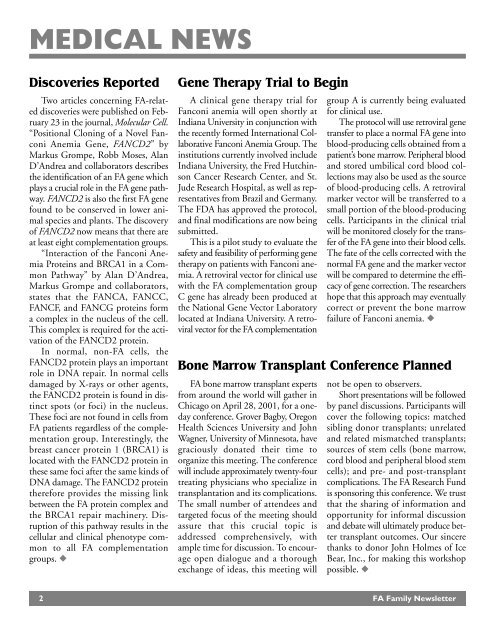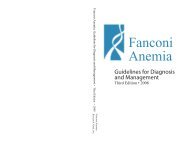FA Family News 3/01 - Fanconi Anemia Research Fund
FA Family News 3/01 - Fanconi Anemia Research Fund
FA Family News 3/01 - Fanconi Anemia Research Fund
You also want an ePaper? Increase the reach of your titles
YUMPU automatically turns print PDFs into web optimized ePapers that Google loves.
MEDICAL NEWS<br />
Discoveries Reported<br />
Two articles concerning <strong>FA</strong>-related<br />
discoveries were published on February<br />
23 in the journal, Molecular Cell.<br />
“Positional Cloning of a Novel <strong>Fanconi</strong><br />
<strong>Anemia</strong> Gene, <strong>FA</strong>NCD2” by<br />
Markus Grompe, Robb Moses, Alan<br />
D’Andrea and collaborators describes<br />
the identification of an <strong>FA</strong> gene which<br />
plays a crucial role in the <strong>FA</strong> gene pathway.<br />
<strong>FA</strong>NCD2 is also the first <strong>FA</strong> gene<br />
found to be conserved in lower animal<br />
species and plants. The discovery<br />
of <strong>FA</strong>NCD2 now means that there are<br />
at least eight complementation groups.<br />
“Interaction of the <strong>Fanconi</strong> <strong>Anemia</strong><br />
Proteins and BRCA1 in a Common<br />
Pathway” by Alan D’Andrea,<br />
Markus Grompe and collaborators,<br />
states that the <strong>FA</strong>NCA, <strong>FA</strong>NCC,<br />
<strong>FA</strong>NCF, and <strong>FA</strong>NCG proteins form<br />
a complex in the nucleus of the cell.<br />
This complex is required for the activation<br />
of the <strong>FA</strong>NCD2 protein.<br />
In normal, non-<strong>FA</strong> cells, the<br />
<strong>FA</strong>NCD2 protein plays an important<br />
role in DNA repair. In normal cells<br />
damaged by X-rays or other agents,<br />
the <strong>FA</strong>NCD2 protein is found in distinct<br />
spots (or foci) in the nucleus.<br />
These foci are not found in cells from<br />
<strong>FA</strong> patients regardless of the complementation<br />
group. Interestingly, the<br />
breast cancer protein 1 (BRCA1) is<br />
located with the <strong>FA</strong>NCD2 protein in<br />
these same foci after the same kinds of<br />
DNA damage. The <strong>FA</strong>NCD2 protein<br />
therefore provides the missing link<br />
between the <strong>FA</strong> protein complex and<br />
the BRCA1 repair machinery. Disruption<br />
of this pathway results in the<br />
cellular and clinical phenotype common<br />
to all <strong>FA</strong> complementation<br />
groups. ◆<br />
Gene Therapy Trial to Begin<br />
A clinical gene therapy trial for<br />
<strong>Fanconi</strong> anemia will open shortly at<br />
Indiana University in conjunction with<br />
the recently formed International Collaborative<br />
<strong>Fanconi</strong> <strong>Anemia</strong> Group. The<br />
institutions currently involved include<br />
Indiana University, the Fred Hutchinson<br />
Cancer <strong>Research</strong> Center, and St.<br />
Jude <strong>Research</strong> Hospital, as well as representatives<br />
from Brazil and Germany.<br />
The FDA has approved the protocol,<br />
and final modifications are now being<br />
submitted.<br />
This is a pilot study to evaluate the<br />
safety and feasibility of performing gene<br />
therapy on patients with <strong>Fanconi</strong> anemia.<br />
A retroviral vector for clinical use<br />
with the <strong>FA</strong> complementation group<br />
C gene has already been produced at<br />
the National Gene Vector Laboratory<br />
located at Indiana University. A retroviral<br />
vector for the <strong>FA</strong> complementation<br />
Bone Marrow Transplant Conference Planned<br />
<strong>FA</strong> bone marrow transplant experts<br />
from around the world will gather in<br />
Chicago on April 28, 20<strong>01</strong>, for a oneday<br />
conference. Grover Bagby, Oregon<br />
Health Sciences University and John<br />
Wagner, University of Minnesota, have<br />
graciously donated their time to<br />
organize this meeting. The conference<br />
will include approximately twenty-four<br />
treating physicians who specialize in<br />
transplantation and its complications.<br />
The small number of attendees and<br />
targeted focus of the meeting should<br />
assure that this crucial topic is<br />
addressed comprehensively, with<br />
ample time for discussion. To encourage<br />
open dialogue and a thorough<br />
exchange of ideas, this meeting will<br />
group A is currently being evaluated<br />
for clinical use.<br />
The protocol will use retroviral gene<br />
transfer to place a normal <strong>FA</strong> gene into<br />
blood-producing cells obtained from a<br />
patient’s bone marrow. Peripheral blood<br />
and stored umbilical cord blood collections<br />
may also be used as the source<br />
of blood-producing cells. A retroviral<br />
marker vector will be transferred to a<br />
small portion of the blood-producing<br />
cells. Participants in the clinical trial<br />
will be monitored closely for the transfer<br />
of the <strong>FA</strong> gene into their blood cells.<br />
The fate of the cells corrected with the<br />
normal <strong>FA</strong> gene and the marker vector<br />
will be compared to determine the efficacy<br />
of gene correction. The researchers<br />
hope that this approach may eventually<br />
correct or prevent the bone marrow<br />
failure of <strong>Fanconi</strong> anemia. ◆<br />
not be open to observers.<br />
Short presentations will be followed<br />
by panel discussions. Participants will<br />
cover the following topics: matched<br />
sibling donor transplants; unrelated<br />
and related mismatched transplants;<br />
sources of stem cells (bone marrow,<br />
cord blood and peripheral blood stem<br />
cells); and pre- and post-transplant<br />
complications. The <strong>FA</strong> <strong>Research</strong> <strong>Fund</strong><br />
is sponsoring this conference. We trust<br />
that the sharing of information and<br />
opportunity for informal discussion<br />
and debate will ultimately produce better<br />
transplant outcomes. Our sincere<br />
thanks to donor John Holmes of Ice<br />
Bear, Inc., for making this workshop<br />
possible. ◆<br />
2 <strong>FA</strong> <strong>Family</strong> <strong>News</strong>letter

















